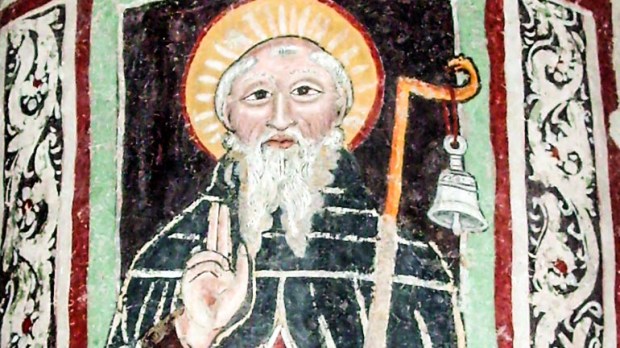Motorcyclists, on the whole, do not have an especially holy reputation. And many of them don’t seem to want one. However, bikers still have a patron saint in Columban, whose feast day is November 23.
Columban – often known as “Columbanus,” the Latinized version of his name – was born in 543 A.D. in the eastern Irish province of Leinster. Details of his youth are rather obscure at this point, but we know that he came from a prominent family and received his early education in northern Ireland. He also was of pleasing appearance and enjoyed the admiration of young women – so much so, in fact, that a pious old local woman warned him about sinful behavior. Heeding the warning, he chose to forsake worldly life and become a monk.
His mother objected strongly to this decision and even threw herself to the ground, begging him not to leave. Columban remarked that “whoever loved his father or mother more than Christ is unworthy of Him,” before stepping around her and leaving his home and family forever.
He entered Bangor Abbey on Ireland’s northeastern coast. At that time, this abbey had such a reputation that it was dubbed “the light of the world.” There Columban stayed for many years, receiving a first-class education. Different accounts give different dates as to when Columban left his native land. Whatever the exact year of his departure, once he ventured from Ireland he would never return.
He headed to the French region of Burgundy, where even though many of the people were Christian in name, “vice and crime were everywhere triumphant.” He sought refuge deep in the forest before he and fellow missionaries founded a monastery at Luxeuil, which began to attract many recruits.
He founded several monasteries in the region and disputed with area Church officials over when to celebrate Easter. He was not a friendly negotiator, and the strength of his convictions “could border on rashness,” as related by Burnam W. Reynolds in his book Columbanus: Light on the Early Middle Ages. Yet Columban commanded such respect that even pagan aristocrats sought him out to educate their sons.
As fearless as he was righteous, Columban once stormed onto a scene of debauchery and smashed the cask of alcohol. His objections were not confined to revelers either: He would tell bishops, kings, even popes, where he felt they went wrong. And he made enemies due to his criticism of local clergy whom he viewed as debased.
Among other important people he criticized was King Thierry, whom he was threatening to excommunicate for maintaining a harem at the royal palace. When the king and queen showed up at Columban’s monastery, he refused them entry because he adhered to the Irish practice of banning female visitors from such venues, even if the woman was a queen.
The rebuffed and incensed king didn’t want to make a martyr out of Columban, so he had him forcibly removed instead. Upon his expulsion, Columban had intended to return to Ireland – until he was halted on French shores by a powerful storm, which he regarded as a sign that God did not want him to go home but instead wanted him to venture further into the European continent.
So he migrated to what is now Switzerland, where he preached to pagans. Many of the area’s inhabitants believed in a god named Woden, whom they worshipped beneath oak trees. Disapproving of such activity, Columban began prowling the woods with an axe in hand, laying waste to the heathens’ sacred oaks. When he wasn’t swinging his axe, he might instead set fire to a pagan temple. These antics once again saw him forcibly dispatched from the area.
By now, Columban was 70 years old. Yet he remained adventurous enough to cross the Alps en route to northern Italy, where he established a monastery at Bobbio, outside of Milan. He lived as a hermit in a cave near this monastery until his death in November 615.
Soon after his passing, one of his monastic disciples composed a Columban biography, preserving information about this uncompromising saint whom his more modern biographer, Reynolds, credits with creating “a unified Western concept of monastic life.”
Because of his love for the open road, Columban was suggested as a patron for bikers by John Oliver, an Anglican bishop and avid motorcyclist. The Vatican declared Columban a patron in 2002.
Thus his headstrong legacy also includes his patronage of bikers – some of whom, like Columban, actually are passionate about the Catholic faith.

